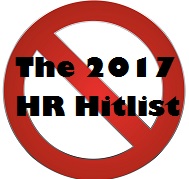 Note: This is the third in a series of five articles from thought leader Jason Lauritsen. Called the 2017 HR Hitlist, each article outlines one practice or behavior that HR needs to eliminate in 2017 and how to do it. The articles originally appeared on the Small Improvements blog. Links to previous posts are at the end of this article.
Note: This is the third in a series of five articles from thought leader Jason Lauritsen. Called the 2017 HR Hitlist, each article outlines one practice or behavior that HR needs to eliminate in 2017 and how to do it. The articles originally appeared on the Small Improvements blog. Links to previous posts are at the end of this article.
When I first started railing against the performance appraisal process years ago, my colleagues in HR were the first to defend it.
- We have to do appraisals to protect ourselves legally.
- We can’t make fair decisions about pay increases without an appraisal.
- We have to have some record of performance.
- You can’t assess performance without ratings.
The ironic thing was that many of these same colleagues actually despised the very process they were defending. It was cumbersome, time consuming, and they knew the information contained in the appraisals was questionable in far too many cases.
While defending it, they had to ignore the truth that performance appraisals are often inflated by managers looking to avoid conflict. Plus, they had been telling managers that appraisals were a legal requirement for so long, they’d forgotten that it’s not actually true.
The process was broken and they knew it. But, they defended it because they felt like they had to.
There can be no innovation or progress unless we’re open to the possibility of a better way. The black or white, yes or no, approach to HR does not work in a world of perpetual and accelerating change. As a consequence, HR is riddled with ineffective, old management practices born in an age of industrialization that have no place in today’s world of work.
While it seems that perhaps we’ve made progress towards replacing the traditional performance appraisal process, that’s only the beginning.
How should interviewing and selection change due to the fact that people are really bad at evaluating other people? Or, what happens to compensation when we consider the evidence that financial bonuses are negatively correlated with performance for complex and creative work?
We must stop defending and protecting “best practices” in HR. Instead, we need to adopt a mindset of innovation and progress. Here are some steps for how to get started.
Don’t be defensive — be curious
When customers hate a product feature, the creator of that product figures out why and makes changes. If they don’t, they are sunk. We need to think about HR in the same way. If the customers (employees and managers) hate a process, defending it only makes things worse. Instead, we should be asking questions to understand what’s not working and strive to fix it. Our goal in HR should be to facilitate a work experience that’s engaging and productive. If our processes are getting in the way of that, they need to change.
Know why and measure
One of the most powerful questions you can ask of any HR practice or process is this: What does success look like? And once you know the answer, how will you measure success?
Take for example the employee handbook. Almost every organization has one. And most are rarely (if ever) read by employees. What does success look like for the employee handbook? If HR is honest, success is simply having one that’s updated (check that box). Not a satisfying or productive answer. That might lead to better questions like, “Why do we need an employee handbook?” and, “What are we trying to accomplish for employees with this handbook?” This is where progress begins.
Check the science
Human resources is first and foremost about the humans. And there are expansive fields of study that provide scientific insights about how humans tick and what motivates us. When it’s time to design HR processes or employee experiences, instead of turning to outdated practices (e.g. performance appraisals), look first to the fields of psychology, brain science, sociology and behavioral economics for insight into how to design in a way that’s good for the humans involved.
Try new things
To really move HR forward in your organization, create opportunities to experiment. Have an idea for a new way to provide performance feedback? Find a manager who is open to trying new things and invite them to test it and measure the results.
Early in my HR career, one of my mentors, Cy Wakeman, taught me to “work with the willing.” In other words, find colleagues who are committed to people and spend time giving them support and new ideas. When you find success, share the story as a way to create buy-in.
HR must break free from the shackles of “best practice.” Too much of what was handed down from the past is no longer relevant today. We must innovate.
This starts with shedding our defensiveness and being more open to hearing the voices of those on the other side of our processes and practices. When our processes don’t feel productive or helpful to those whom they’re designed to support, it’s time to make change.
Here are the links to previous articles in this series:
